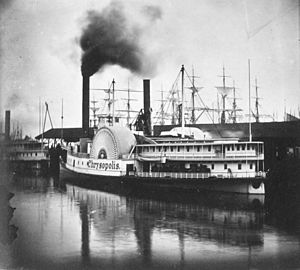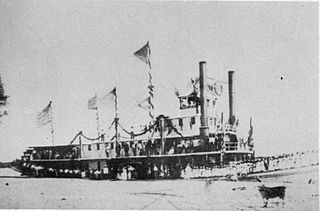 Chrysopolis, at the time it was built North's largest steamboat, and the fastest on the San Francisco - Sacramento run from 1860 - 1875. Rebuilt in 1875 by Patrick Henry Tiernan, it ran as the San Francisco Bay ferry Oakland until 1940. |
| History |
|---|
| Name | Chrysopolis |
| Builder | John Gunder North, in San Francisco |
| Laid down | 1860 |
| Launched | 1860 |
| Fate | Rebuilt in 1875 as the San Francisco Bay ferry Oakland. Destroyed by fire in 1940. |
| General characteristics |
|---|
| Type | Side-wheel paddle steamer |
| Displacement | 1,050 tons |
| Length | 245 feet |
| Beam | 40 feet |
| Draught | 4.5 feet |
| Propulsion | single cylinder, vertical-beam engine |
| Speed | 19.8 knots |
| Notes | Capacity: 1,000 passengers, 700 tons of cargo. |
Chrysopolis, a famous side-wheel steamboat that ran between Sacramento and San Francisco from 1860 to 1875 when it was rebuilt as a ferry that continued in service for more than 60 years.
Chrysopolis was built in San Francisco, by shipbuilder John Gunder North in his new shipyard in the Potrero District. Launched in 1860, it was a side-wheel paddle steamer of 245 feet long with a 40-foot beam, displacing 1050 tons. It was equipped with a 1,357 horsepower, single cylinder, vertical-beam engine powered by two 32 ton boilers. It had two side-wheels 32 feet in diameter with 8 foot buckets (the wooden blades of a paddle wheel). It could carry 1,000 passengers and 700 tons of cargo at great speed. On December 31, 1861, it made the record setting run for a steamboat over the 120 mile distance between Sacramento and San Francisco in 5 hours and 19 minutes, making an average speed of 19.8 knots.

The Pacific Mail Steamship Company was founded April 18, 1848, as a joint stock company under the laws of the State of New York by a group of New York City merchants. Incorporators included William H. Aspinwall, Edwin Bartlett, Henry Chauncey, Mr. Alsop, G.G. Howland and S.S. Howland.

The steamboat Ticonderoga is one of two remaining side-paddle-wheel passenger steamers with a vertical beam engine of the type that provided freight and passenger service on America's bays, lakes and rivers from the early 19th to the mid-20th centuries. Commissioned by the Champlain Transportation Company, Ticonderoga was built in 1906 at the Shelburne Shipyard in Shelburne, Vermont on Lake Champlain.

Delta King is a 285-foot-long sternwheel steamboat (87 m) and the sister ship of Delta Queen, built in Scotland and California for the California Transportation Company's service between Sacramento and San Francisco, California. She entered service in 1927 and continued until 1940. After wartime service with the United States Navy, Delta King served as an accommodation ship at Kitimat, British Columbia in the 1950s and then returned to California for static use at Old Sacramento where she remains as a hotel, restaurant and venue.

Many steamboats operated on the Columbia River and its tributaries, in the Pacific Northwest region of North America, from about 1850 to 1981. Major tributaries of the Columbia that formed steamboat routes included the Willamette and Snake rivers. Navigation was impractical between the Snake River and the Canada–US border, due to several rapids, but steamboats also operated along the Wenatchee Reach of the Columbia, in northern Washington, and on the Arrow Lakes of southern British Columbia.

The steamboat Yosemite operated for almost fifty years on San Francisco Bay, the Sacramento River, inland coastal waters and the lower Fraser River in British Columbia, and Puget Sound.

Steamboats on the Colorado River operated from the river mouth at the Colorado River Delta on the Gulf of California in Mexico, up to the Virgin River on the Lower Colorado River Valley in the Southwestern United States from 1852 until 1909, when the construction of the Laguna Dam was completed. The shallow draft paddle steamers were found to be the most economical way to ship goods between the Pacific Ocean ports and settlements and mines along the lower river, putting in at landings in Sonora state, Baja California Territory, California state, Arizona Territory, New Mexico Territory, and Nevada state. They remained the primary means of transportation of freight until the advent of the more economical railroads began cutting away at their business from 1878 when the first line entered Arizona Territory.
Uncle Sam, was a side-wheel paddle steamer and the first steamboat on the Colorado River in 1852.
Colorado, was a stern-wheel paddle-steamer, the third steamboat on the Colorado River, and first stern-wheel steamboat put on that river, in December 1855.

Colorado, second of its name on the Colorado River, was a stern-wheel paddle-steamer, rebuilt from the original Colorado was the fifth steamboat on the Colorado River. It was first put on the river in December 1862.

John Gunder North was a Norwegian born ship builder in San Francisco. During his career, he built 273 hulls of all kinds with 53 bay and river steamers, including the famed paddle steamers Chrysopolis, Yosemite and Capital.

Capital, a famous side-wheel steamboat that ran between Sacramento and San Francisco from 1866 to 1896.
Esmerelda, was a stern-wheel paddle-steamer, built for the Sacramento River trade, in 1864 it became the first of the opposition steamboats on the Colorado River. It was also the first steamboat to tow large cargo barges on that river, in May 1864 and to reach Callville, Nevada in 1866.
Mohave was the first stern-wheel steamboat of that name running on the Colorado River between 1864 and 1875.
Domingo Marcucci Jugo, was a Venezuelan born 49er, shipbuilder and shipowner in San Francisco, California. He owned or captained some of the many steamships, steamboats, ferries, and sailing ships he built at San Francisco and elsewhere on the Pacific coast.
Georgiana, a small side-wheel steamboat made in Philadelphia in 1849, one of the first on the waters of the Mokelumne River, Sacramento, San Joaquin and Tuolumne Rivers of California.
Steamboats operated in California on San Francisco Bay and the Sacramento–San Joaquin River Delta, and Sacramento River as early as November 1847, when the Sitka built by William A. Leidesdorff briefly ran on San Francisco Bay and up the Sacramento River to New Helvetia. After the first discovery of gold in California the first shipping on the bays and up the rivers were by ocean going craft that were able to sail close to the wind and of a shallow enough draft to be able to sail up the river channels and sloughs, although they were often abandoned by their crews upon reaching their destination. Regular service up the rivers, was provided primarily by schooners and launches to Sacramento and Stockton, that would take a week or more to make the trip.
Gila, a stern-wheel steamboat of the Colorado Steam Navigation Company running on the Colorado River between 1873 and 1899.
George A. Johnson & Company was a partnership between three men who pioneered navigation on the Colorado River. Benjamin M. Hartshorne, George Alonzo Johnson and Alfred H. Wilcox. The George A. Johnson & Company was formed in the fall of 1852, and was reorganized as the Colorado Steam Navigation Company in 1869.

Mohave, the second stern-wheel steamboat of that name running on the Colorado River for the Colorado Steam Navigation Company (C.S.N.C) between 1875 and 1876. It was the first and only double smokestack steamboat to run on the river.
Clinton was the first steam ferry built in California and used on San Francisco Bay in 1853.









